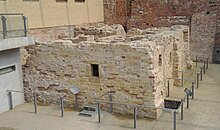Augustinian monastery in Wittenberg

The Augustinian Monastery (also Black Monastery ) was a monastery of the Augustinian hermits in Wittenberg in what was then the Electorate of Saxony from 1504 to 1524.
location
The monastery was located in the eastern part of the medieval city near the Elstertor directly on the city wall. Today the Lutherhaus (Augusteum) is located there .
history
The monastery was probably founded in 1504. The monastery complex was built on the site of the previous Heilig-Geist-Spital. The monastery was used especially to accommodate foreign Augustinian monks who studied at the Wittenberg University , which was founded shortly before . Martin Luther came to Wittenberg in 1508 and has lived in the monastery ever since. In 1517 he started the Reformation with the publication of his theses .
At the end of 1521, 15 monks had left the monastery. In January 1522 the remaining brothers were allowed to leave the monastery. Since March of that year, after his return from the Wartburg, Luther lived again in the monastery, together with a few remaining monks. In 1524 the elector Friedrich transferred the building complex to him.
Structures
The monastery was run by a prior . In the meantime more than 40 monks lived there, most of them foreign Augustinians who studied at the university.
The monastery received income from some villages in the area as well as from foundations and donations. Dates are not known.
Personalities
Vicar General of the Augustinians
- Johannes Staupitz , lived in Wittenberg from 1502–1512, co-founded the university in 1502
Priors
- Johann Domeczer, 1504
- Gregor Mayer, 1504
- Johann Herrgott, 1505/06
- Melchior Mirisch , 1509–1510, lived in the monastery from 1507–1510 / 12
- Wenzeslaus Linck , 1511–1515, dean of the theological faculty 1512–1514, lived in the monastery from 1503–1516
- Jakob Propst , 1515–1518
- Adam Ulrich, 1518, was in Wittenberg as early as 1502
- Konrad Helt , 1519–1522, lived in the monastery from 1512–1522
- Eberhard Brisger , 1522–1523, lived in the monastery from 1518–1525
Subpriorities
- Martin Luther , 1512–1515, district vicar 1515–1518, lived in the monastery from 1508–1509, 1512–1521, 1522–1524, then as personal property until 1546
More monks
- Heinrich von Zutphen , 1508–1516
- Johann Westermann , 1510
- Johann Lange , 1511–1515
- Gabriel Zwilling , 1512-1517, 1519-1521
- Georg Spenlein , 1512-1516
- Tilemann Schnabel , 1515
- Heinrich Himmel , 1516 – before 1521
printer
- Johann Gronenberg , had a print shop in the monastery from 1508–1523
Further use
In 1564, Luther's heirs left the grounds to the university.
literature
- Gottfried Wentz : The Augustinian Hermitage in Wittenberg . In: Gottfried Wentz, Fritz Bünger (edit.): The Diocese of Brandenburg. Part 2. (= Germania sacra. I. Department: The Dioceses of the Church Province of Magdeburg. 3. Volume) . Berlin and Leipzig 1941. pp. 440-499. ( Digital copy , PDF )
- Reinhard Schmitt / Mirko Gutjahr: The "Black Monastery" in Wittenberg. Building research and archeology in and at the monastery of the Augustinian hermits and Martin Luther's house . In: Harald Meller (Ed.): Fundsache Luther. Archaeologists in the footsteps of the reformer , Theiss Verlag 2008. pp. 132-139.
Individual evidence
- ↑ Reinhard Schmitt, Mirko Gutjahr: The Black Monastery . S. 133-134 .
- ↑ Wentz, Augustinian Hermit Monastery , p. 460
- ↑ Biographical information on all the monks mentioned in Wentz, Augustinereremitenkloster , pp. 460–499. ( Digital copy , PDF )
